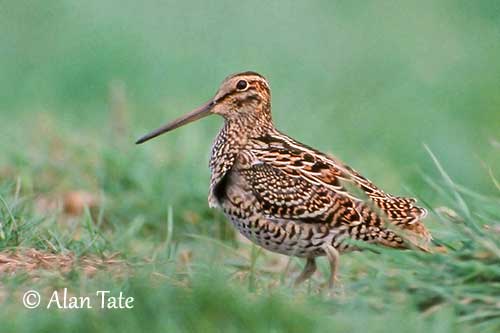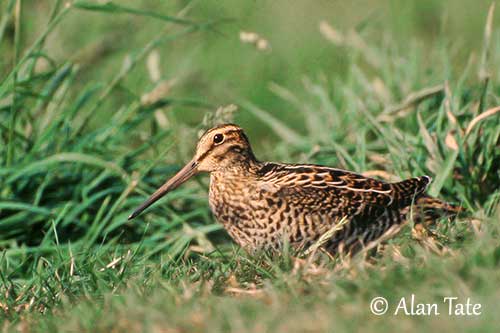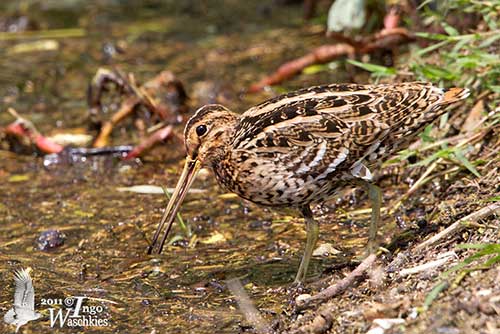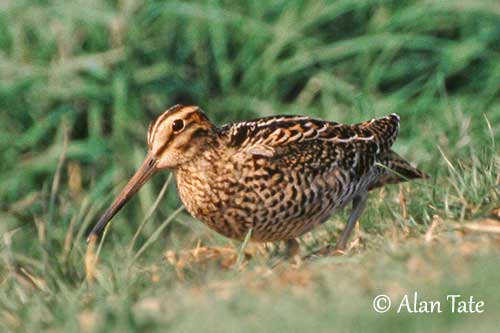
Fr: Bécassine double
Ang: Great Snipe
All: Doppelschnepfe
Esp: Agachadiza Real
Ita: Croccolone
Nd: Poelsnip
Sd: Dubbelbeckasin
Photographers:
Alan & Ann Tate
AA Bird Photography
Ingo Waschkies
My bird pictures on Pbase
Text by Nicole Bouglouan
Sources:
HANDBOOK OF THE BIRDS OF THE WORLD Vol 3 by Josep del Hoyo-Andrew Elliott-Jordi Sargatal - Lynx Edicions - ISBN : 8487334202
THE HANDBOOK OF BIRD IDENTIFICATION FOR EUROPE AND THE WESTERN PALEARCTIC by Mark Beaman, Steve Madge - C. Helm - ISBN: 0713639601
SHOREBIRDS by Peter Hayman, John Marchant and Tony Prater – Christopher Helm – 1986 – ISBN: 0747014035
GUIDE DES LIMICOLES de D. Taylor - Delachaux et Niestlé - ISBN : 2603014080
BIRDS OF THE GAMBIA AND SENEGAL by Clive Barlow and Tim Wacher – Helm Field guides – ISBN: 0713675497
Wikipedia, the free encyclopaedia
The Royal Society Publishing – Biology Letters
Planet Earth Online – News from the Natural World
Great Snipe
Gallinago media
Charadriiformes Order – Scolopacidae Family
INTRODUCTION:
The Great Snipe is part of the subfamily Gallinagininae within the family Scolopacidae. This snipe is mostly rare and local. Compared to the Common Snipe, it is larger and bulkier, but surprisingly shorter-billed. It may resemble the Eurasian Woodcock in body structure and flight action when flushed.
The Great Snipe is migratory. It breeds in the northern half of Europe and spends the winter in sub-Saharan Africa.
It is threatened by habitat loss and degradation on the breeding grounds, and hunting pressure in E Europe and winter range.
The Great Snipe is known for its fast, non-stop flight over long distances, with some birds recorded flying non-stop for 48 hours and over more than 4500 kilometres.

DESCRIPTION OF THE BIRD:
Biometrics:
Length: 27-29 cm
Wingspan: 47-50 cm
Weight: 140-260 g
The Great Snipe has dark brown upperparts with narrow buff and paler brown vermiculations and narrow pale lines. On the upperwing, the wing-coverts show bold white tips. The flight-feathers are dark brown. The uppertail shows white outer rectrices except for the dusky base.
On the underparts, neck and upper breast are washed pale brown, with heavy dark brown spotting and streaking, forming chevrons on the lower breast. Whitish flanks and belly are heavily barred blackish, but centre of belly in white and unbarred. Underwing-coverts and axillaries are barred brown and white, but appear mostly dark.
The head pattern is typical of snipes, but with slightly narrower line across lores, duskier ear-coverts, and heavier dark spotting on sides of face.
The bill is dark brown with yellowish to greenish-brown base. It shows a slight downwards angle half-way along the upper mandible. The eyes are dark brown. Legs and feet are pale greyish-green to dull brownish-yellow.
Male and female have similar plumage, but the female is slightly larger than male.
The juvenile resembles adults but the upperparts show narrower streaks and less conspicuous white tips to wing-coverts, and the white outer rectrices are faintly barred brown.
RANGE:
The Great Snipe breeds in Scandinavia, E through Baltic States, Poland and W Russia to R Yenisei. It winters in sub-Saharan Africa and occasionally in Middle-East.
HABITAT:
The Great Snipe breeds in grassy bogs, marshes with sedges, damp meadows, usually bordered by bushes or forest. It may breed locally in drier woodland near marshes and bogs. On passage, it can be found in wet fields with short grass, marshland edges, meadows, and swamps with sedges. It winters in similar habitats, in ricefields and recently flooded areas.

CALLS AND SONGS: SOUNDS BY XENO-CANTO
When flushed, the Great Snipe produces weak, croaking “etch-etch-etch” often masked by the noisy wingbeats. These calls are also given during the flight. Courtship displays at lek are accompanied by bill-clattering, vocal drumming and gurgling, tinkling, clicking and buzzing noises, and by a twittering “bipp-bipp-bippbippbipp”.
The Great Snipe is usually silent during migration and winter.
BEHAVIOUR IN THE WILD:
The Great Snipe feeds on invertebrates and mainly earthworms, but gastropods, insect larvae and adults, and seeds from aquatic plants are also part of its diet.
It may feed alone or in small groups, and is usually more active towards the dusk and at night. It probes the soil or the water with its long bill while searching for preys. But it also pecks from the surface.
During the breeding season, several males gather at communal leks to display. They jump noisily and fight from tussocks with an upright stance and pouting breast. They perform bill-fencing while the tail is fanned to display the white outer rectrices. They also fly low over the lek. Displays are accompanied by songs and occur after sunset.
The females visit the leks only for mating, and they select a male based on some typical features. Copulation occurs in the centre of the lek, occasionally at the edge.
After the displays, the leks can be recognized by the pattern of trampled grass.
The Great Snipe is the only member of genus Gallinago with no aerial displays. Outside the breeding season, they are found singly or in small groups in marshy areas.
The Great Snipe is migratory and leaves the breeding grounds in August. It arrives at the wintering areas in sub-Saharan Africa just after the rainy season.
For an observation, several males were equipped with geolocators, and three of them were found and recaptured. In late August, they flew 6170, 6800 and 4620 kilometres non-stop from their northern breeding range, S to sub-Saharan Africa. The flights lasted for 72, 84 and 48 hours respectively. The return to N is fairly similar in duration, but with several short flights interspersed with short stopovers, until arriving at their breeding grounds. They almost double their body weight before the autumn migration, but not for the return. That explains why the birds need to make stopovers for feeding during the return migration.

The non-stop flights are notably fast in spite of relatively rounded wings, and occur at high altitude. The lateral wind drift involves curved shape of migration routes and increases the travel distance, but also contributes to high speeds.
The flight of the Great Snipe is direct, with the long bill held horizontal during the flight.
REPRODUCTION OF THIS SPECIES:
The laying takes place between mid-May and early July. The nest is built by the female alone, and the male does not take part in nesting duties. The nest is on the ground, a shallow depression lined with moss or grass, concealed among the thick vegetation for better protection.
The female lays 3-5 cryptic eggs and incubates during 22-24 days. The downy chicks have cryptic plumage too. They leave the nest immediately and are able to feed themselves very soon. They fledge between 21 and 28 days after hatching, and are independent.
PROTECTION / THREATS / STATUS:
The Great Snipe is threatened by habitat loss through degradation of the nesting areas. Habitat loss is due to agriculture expansion, drainage of wetlands and creation of reservoirs involving submergence of river valleys. It is also affected by hunting pressure in E Europe and on the wintering grounds. Several thousands of birds are killed in a few days. The Scandinavian population is threatened by climate change involving habitat loss.
The population estimate varies from 450,000 – 1,000,000 individuals in 2007, to 118,000 – 1,051,000 individuals in 2012. But the numbers are poorly known. This population is decreasing.
But currently, the Great Snipe is listed as Near Threatened.
